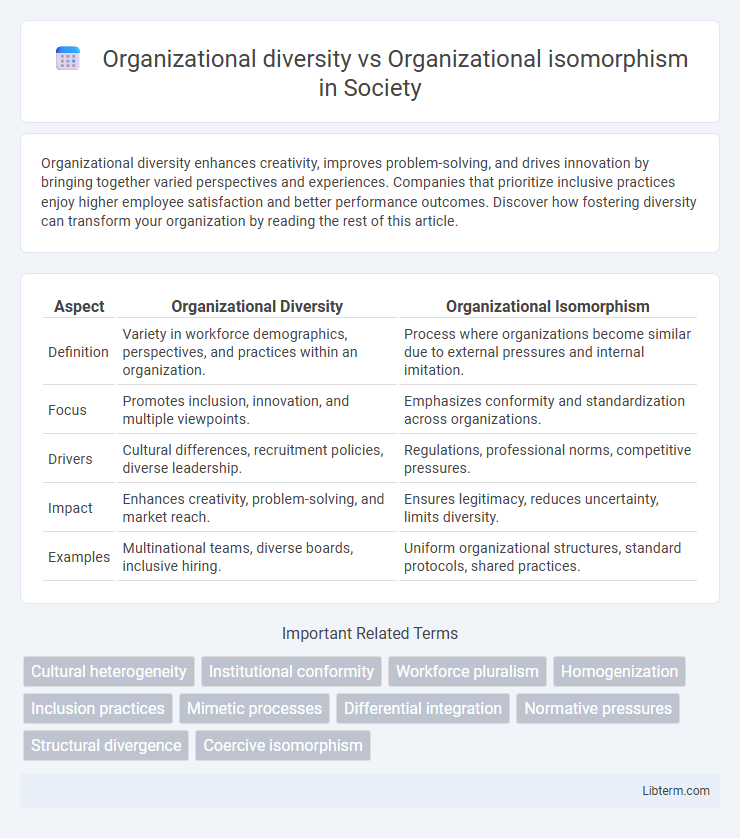Organizational diversity enhances creativity, improves problem-solving, and drives innovation by bringing together varied perspectives and experiences. Companies that prioritize inclusive practices enjoy higher employee satisfaction and better performance outcomes. Discover how fostering diversity can transform your organization by reading the rest of this article.
Table of Comparison
| Aspect | Organizational Diversity | Organizational Isomorphism |
|---|---|---|
| Definition | Variety in workforce demographics, perspectives, and practices within an organization. | Process where organizations become similar due to external pressures and internal imitation. |
| Focus | Promotes inclusion, innovation, and multiple viewpoints. | Emphasizes conformity and standardization across organizations. |
| Drivers | Cultural differences, recruitment policies, diverse leadership. | Regulations, professional norms, competitive pressures. |
| Impact | Enhances creativity, problem-solving, and market reach. | Ensures legitimacy, reduces uncertainty, limits diversity. |
| Examples | Multinational teams, diverse boards, inclusive hiring. | Uniform organizational structures, standard protocols, shared practices. |
Introduction to Organizational Diversity and Isomorphism
Organizational diversity refers to the variety of structures, cultures, and practices that exist within and among organizations, promoting innovation and adaptability in competitive environments. Organizational isomorphism describes the process by which organizations within the same field become increasingly similar over time due to institutional pressures, such as coercive, mimetic, and normative forces. Understanding the balance between diversity and isomorphism is crucial for analyzing how organizations evolve while maintaining legitimacy and responding to external demands.
Defining Organizational Diversity
Organizational diversity refers to the presence of varied characteristics within a company, including differences in culture, skills, demographics, and perspectives that contribute to innovation and adaptability. This diversity enhances problem-solving abilities and drives competitive advantage by leveraging unique viewpoints and experiences. In contrast, organizational isomorphism involves companies adopting similar structures and practices, often limiting diversity by promoting uniformity and conformity within industries.
Understanding Organizational Isomorphism
Organizational isomorphism refers to the process by which organizations in the same field become increasingly similar over time due to external pressures such as regulations, norms, and competition. This phenomenon contrasts with organizational diversity, where firms maintain distinct structures and practices to innovate and adapt uniquely. Understanding organizational isomorphism involves analyzing coercive, mimetic, and normative forces that drive conformity across institutions, ultimately affecting organizational behavior and strategy.
Historical Context and Evolution of Concepts
Organizational diversity refers to the variety of structures, cultures, and practices within organizations, evolving from early anthropological and sociological studies identifying the benefits of heterogeneous work environments. Organizational isomorphism, rooted in institutional theory developed in the 1970s by DiMaggio and Powell, describes the process through which organizations within the same field become more homogenous due to coercive, mimetic, and normative pressures. Historically, these concepts have evolved with globalization and technological advances, highlighting a dynamic tension between the drive for uniqueness through diversity and the organizational pressure toward conformity for legitimacy and efficiency.
Drivers of Organizational Diversity
Organizational diversity is driven by factors such as varying market demands, cultural differences, leadership styles, and innovation goals, which foster unique structures and practices tailored to specific contexts. In contrast, organizational isomorphism occurs when institutions adopt similar strategies and structures due to regulatory pressures, mimetic processes, and normative influences to achieve legitimacy and efficiency. Understanding these drivers helps explain why organizations either embrace distinctiveness through diversity or conform to common norms via isomorphism.
Mechanisms of Organizational Isomorphism
Mechanisms of organizational isomorphism include coercive, mimetic, and normative pressures that drive organizations to become similar in structure and practices, enhancing legitimacy and stability within their institutional environments. Coercive isomorphism arises from formal and informal pressures exerted by regulatory bodies or dominant organizations, while mimetic isomorphism occurs when firms imitate successful peers under conditions of uncertainty. Normative isomorphism stems from professionalization and shared norms among organizational members, promoting conformity through education and professional networks.
Impacts on Innovation and Performance
Organizational diversity enhances innovation and performance by integrating varied perspectives, fostering creativity, and enabling adaptive problem-solving across departments. In contrast, organizational isomorphism leads to homogenization of processes and structures, which can stifle innovation and reduce competitive advantage by limiting unique strategic responses. Studies reveal diverse organizations often outperform isomorphic counterparts through increased knowledge sharing, improved decision-making, and greater market responsiveness.
Organizational Diversity vs Isomorphism: Key Differences
Organizational diversity refers to the varied characteristics, practices, and structures within organizations that promote innovation and adaptability, while organizational isomorphism describes the process by which organizations become similar due to external pressures and institutional norms. The key difference lies in diversity fostering uniqueness and competitive advantage, whereas isomorphism leads to conformity and reduced differentiation among organizations. Understanding these distinctions helps in managing organizational change and strategic positioning in dynamic environments.
Strategies for Balancing Diversity and Conformity
Strategies for balancing diversity and conformity in organizations involve integrating diverse perspectives while maintaining core organizational values to foster innovation without sacrificing cohesion. Implementing inclusive leadership practices and promoting adaptive cultural frameworks enables organizations to embrace heterogeneity and resist the pressures of isomorphic conformity. Leveraging cross-functional teams and continuous feedback mechanisms also supports dynamic adjustments, ensuring both diversity-driven creativity and standardized operational efficiency coexist effectively.
Future Trends in Organizational Structure
Future trends in organizational structure emphasize increasing organizational diversity through inclusive leadership, multicultural teams, and adaptive work environments that foster innovation and resilience. Organizations are moving away from organizational isomorphism, which promotes uniformity and mimetic behavior, in favor of customized, flexible structures tailored to dynamic market demands and technological advancements. The integration of AI, remote work, and decentralized decision-making further accelerates the shift toward diverse, agile organizations that differentiate themselves rather than conforming to industry norms.
Organizational diversity Infographic

 libterm.com
libterm.com